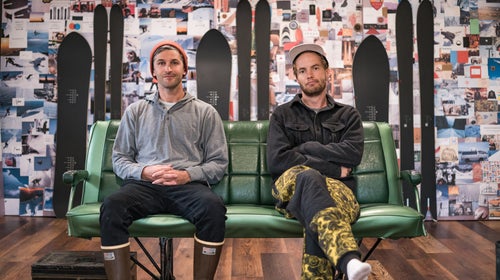The first thing skier says on our call is that he knows that what his startup╠řbusiness is╠řdoing is slightly hypocritical. HeÔÇÖs Zooming from in front of the mood board at the Oregon headquarters of , the ski and snowboard company╠řheÔÇÖs launching with snowboarder . The two pro╠řathletesÔÇöalong with a team of industry vets from Armada, K2, and LineÔÇöare selling new skis and boards╠řin part╠řto get people to buy fewer of them.
ItÔÇÖs╠řgift-guide and new-ski season, but itÔÇÖs also the time of year when we╠řcan most feel the itch of consumerism. WeÔÇÖre╠řstuck at home clicking on╠řpictures of the latest shiny versions of╠řitems╠řwe╠řalready have.╠řThe tension of trying to be a good consumerÔÇötrying to keep our personal footprints smallÔÇörubs up against the appeal of different, better things. And in the gear world, where equipment can make a real difference in performance, the pull of new products is strong.
Like so much of╠řthe outdoor industry, sales of snow hard goods are predicated on a seasonal cycle of emerging╠řproducts. Every fall, brands roll out new models and tout their innovations in an attempt╠řto sell as much gear as possible before the holiday rush. And that sales cycle is a significant economic spike. A November report from the U.S. Bureau of Economic Affairs found that outdoor recreation added $459.8 billion to the American economy last yearÔÇöand retail was nearly a quarter of that.
Smith and Pollard have been sponsored athletes since they were teenagers. Pollard, who is also an artist, spent 21 years riding for Line skis and put out nearly 50 coveted pro models that feature both his ski design and his artwork. SmithÔÇÖs Nitro boards have a similar cult following. But both started to feel uncomfortable constantly creating new products when those products╠řwerenÔÇÖt all that different from the previous╠řyearÔÇÖs gear. They knew it made sense╠řbusiness-wise, but it felt morally questionable and uncreative.
ÔÇťSelling new jackets to our buddies year after year started to eat at our souls,ÔÇŁ Pollard says. ÔÇťThe old equation worked, it had a lot of blue sky, but we donÔÇÖt want to be the old band playing the hits.ÔÇŁ
The two started talking╠řabout what they, as athletes who had been heavily involved in product design and who had some cultural sway, could do to change snow sportsÔÇÖ product footprint, to slow it down and make skis and boards╠řwith longer lives. They looked at other industries, like construction, for inspiration. ÔÇťItÔÇÖs not like you go out and buy a new hammer every year,ÔÇŁ Smith says.
He and Pollard decided they were going to make three board models and three ski models, all built to last. The products╠řhave black topsheets (which╠řwill stay the same every year), versatile shapes, and come with a built-in maintenance plan through Evo, which will provide free tuning╠řand waxing. ÔÇťIt feels right in terms of taking some responsibility,ÔÇŁ Smith says. ÔÇťIf we were going to speak to longevity, we had to put our money where our mouth was.ÔÇŁ
SeasonÔÇÖs plan is to change the footprint and life span of its╠řproducts╠řand to share that responsibility between the brand (which will break╠řthe new-gear-every-year product cycle), the shop (which will maintain╠řthe product for life), and the user╠ř(who will╠řtheoretically╠řhold on to their gear for a long time). Pollard knows itÔÇÖs not a perfect plan, and he doesnÔÇÖt actually know if itÔÇÖs going to workÔÇöÔÇťMaybe everyone buys our stuff once, and then weÔÇÖre done,ÔÇŁ he saysÔÇöbut he thinks itÔÇÖs╠řimportant to try.
The company is part of a wide, slow wave of conscious consumerism taking hold in╠řthe outdoor industry. The edge of the wave is probably Patagonia, which attracted╠řgood and bad attention with its╠ř2011 ÔÇťÔÇŁ ad,╠řbut it also includes NeedEssentialsÔÇÖ unbranded surfing╠řbasics and╠řREI selling used gear on its website. Season is eyeballing the╠řsame environmental challenge thatÔÇÖs confronting so many sectors, from to╠ř: Can we do itÔÇöwhatever it isÔÇöbetter without sacrificing what consumers expect?
Reducing excess across the outdoor-retail world has to include movement from many different directions. It has to come from change in the supply chain, change in consumer culture, and change in how gear is transported, marketed, and monetized, all while still working within a product-driven economy.
So maybe SeasonÔÇÖs plan is slightly hypocritical, maybe itÔÇÖs not perfect, and maybe it wonÔÇÖt even work, but itÔÇÖs a step forward on an imperfect path that a lot of businesses╠řare trying to walk. And if we wait around for morally pure, totally perfect solutions to the outdoor worldÔÇÖs waste and overuse, itÔÇÖs going to be a long, long wait.


